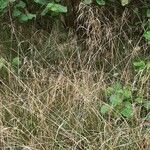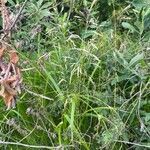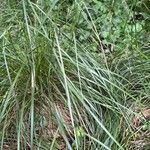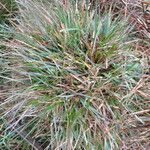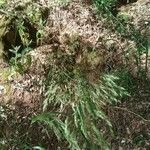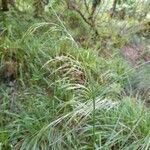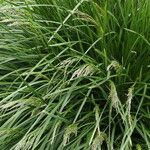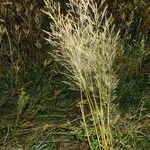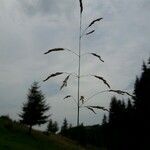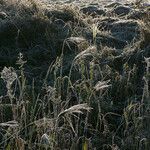Perennial, densely tufted. Culms erect, slender to stout, 30–150 cm tall, 1–3 mm in diam., 1–3-noded. Leaf sheaths loose, glabrous; leaf blades linear, flat or folded, up to 30 cm, 1–5 mm wide, abaxial surface smooth, adaxial surface with coarse sharp ridges, densely scabrid; ligule obtuse to acuminate, 2–7(–12) mm. Panicle usually open, often nodding, infrequently loosely contracted, ovate to narrowly oblong in outline, up to 30 cm or more, greenish or purplish sometimes with golden sheen; branches slender, bearing spikelets on distal part. Spikelets 2.5–7 mm, florets (1–)2(–3), rachilla internode ca. 1 mm; glumes slightly longer to slightly shorter than florets, lower glume slightly shorter than or equaling upper glume, 1-veined, upper glume 3-veined, apex acute; callus hairs ca. 1/3 lemma length; lemmas 2.5–3.5 mm, awned from near base to near middle, rarely awnless, apex broad, toothed or erose; awn straight or slightly bent, slightly shorter to longer than lemma. Anthers 1.2–2 mm. Fl. and fr. Jul–Sep.
Plants shortly rhizomatous and densely caespitose. Culms 20–95 (–200) cm high. Leaf blades 8–27 (–60) cm long, 1.5–4 (–5) mm wide, flat to inrolled. Panicles 6.5–25 (–35) cm long, with 2–5 spikelets on a typical ultimate branch. Spikelets 4–6 (–7) mm long, with 2 or 3 bisexual florets. Glumes exceeding florets; lower glume (3.5–) 4–7 mm long, 1 or 3-nerved; upper glume (4–) 5–7 mm long, 3 or 5-nerved. Callus villous; hairs to 1.5 (–2) mm long. Bisexual florets: lemma narrowly oblong, narrowly elliptic or ovate, 3–4.3 mm long, (obtuse–) truncate, irregularly 2–4-toothed or erose to jagged at apex, membranous, sometimes pigmented, finely 5–7-nerved, often lightly papillose to scaberulous above; lemma awn shortly exceeding or occasionally c. as long as lemma body, 3–4 (–5) mm long, dorsal, arising from near base to c. midway.
Densely tufted perennial tussock grass; culms erect, 30–160 cm. high.. Leaves mostly basal; blades mostly 7–40 cm. long and 2–5 mm. wide, flat, or rolled when dry, coarsely ridged above, scabrid on the ridges and harsh to the touch; ligule scarious, up to 15 mm. long.. Panicle oblong, 10–30 cm. long, loose or rarely ± contracted.. Spikelets narrowly oblong, 2–6.5 mm. long (4–6.5 mm. in Flora area), 2(rarely 3)-flowered, green or purple with a golden or silvery sheen; lower glume oblong to narrowly elliptic, acute or obtuse, the upper elliptic, 3-nerved, acute; lemma elliptic-oblong, 3–4.5 mm. long, 4-toothed, or 2-lobed with the lobes lacerate, awned from near the base, less often from one-third or even half way up the back; awns mostly straight, capillary, 3–5 mm. long, scarcely projecting beyond the glumes.
Densely tufted perennial 3–12 dm; lvs mostly below the middle of the stem, the blades flat or folded, 1–5 mm wide, ligules often elongate to 3–12 mm; infl loose and open to narrow and contracted, the lower branches in fascicles of 2–5; spikelets purplish or silvery, 2.3–5.7 mm, the first glume 2–5.1 mm, the second 2.7–5.3 mm, acute or obtuse and often erose-tipped; rachilla prolonged one-fourth to one-half the length of the upper floret; lemmas glabrous, usually truncate and 4-toothed, the awn attached below the middle, straight or nearly so, from shorter than to barely exceeding the lemma; palea bifid, anthers 1.3–2.3 mm; 2n=24–28, 52, 56. Wet or boggy ground; circumboreal, s. to N.J., W.Va., N.C., Ill., Minn., and Ariz. A complex sp., the vars. not yet well understood.
A grass which has leaves year round. It forms erect tussocks. It grows 1.2-1.8 m high and 1.2-1.5 m wide. The leaves are narrow and dark green. They are 10-60 cm long by 0.2-0.5 cm wide. They are often rolled inwards. The form a dense clump. The leaves have sharp tips. The flowers are airy plumes. They start green or purple and change with the season. They are 10-50 cm long by 15-20 cm wide.
